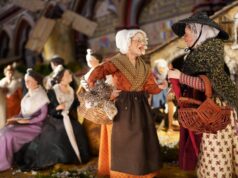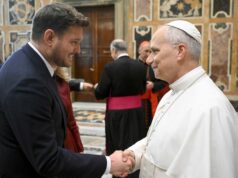
Even though the cakes celebrating Pope Leo XIV’s birthday in his old Diocese of Chiclayo, Peru, appeared a little misshapen — with one of the cakes featured a vertical pope appearing roly poly rather than svelte like Pope Leo — it didn’t matter. The celebration was splendid.
A crowd gathered in the community of Monsefú for the annual celebration of the enthronement of Jesus the Nazarene on Sept. 14, where they cut a 2-meter-long (13-foot-long) cake for Pope Leo, who turned 70 the same day. Pope Leo often visited St. Peter’s Parish — site of the celebration — while serving as bishop, according to news organization Infobae. The curious confectionery captured international attention and became a social media sensation in Peru, where users had previously turned Pope Leo’s election into a gold mine of memes — ranging from good natured to political, in a country with a deep disdain for its elected officials.
But the celebration and reactions reflected the deep enduring affection for Pope Leo in his native Peru, where the American-born pontiff served as an Augustinian missionary and later a bishop.
He also became a citizen of the South American country. His remarks upon being elected May 8 included a special greeting “to my dear Diocese of Chiclayo, Peru, where a faithful people have accompanied their bishop, shared their faith and have given so much, so much to continue to be a faithful Church of Jesus Christ.”
In his first interview as pope for Crux media, he said that “I’m obviously an American and I very much feel that I’m an American, but I also love Peru very much, the Peruvian people, that is a part of who I am.”
Pope Leo, then Bishop Robert Prevost, left a legacy of service in northern Peru, which hasn’t been forgotten, according to locals. He waded into flooded areas wearing rubber boots to deliver relief supplies, he raised funds to install three oxygen plants during the COVID-19 pandemic, which ravaged Peru.
“People have expressed renewed hope and faith in this new pope,” Patrick Espinal, coordinator for a Catholic youth organization in Chiclayo, told OSV News.
Others in Peru have attempted to leverage the pope’s popularity, including politicians.
President Dina Baluarte, whose approval rating hovers near zero, often mentions the pope, Espinal said. “We have seen local regional authorities always talking about the pope and promoting his image. We have also seen business sectors” do the same, he said.
A group of local bakers donated the cakes for the pope’s birthday celebration in Chiclayo. Local restaurants played up connections to the pope after his elections — claiming his fondness for their food.
Businesses are now gearing up for a religious tourism boom in Chiclayo and the surrounding region.

The federal culture ministry reported a 25% increase in visitors to the Lambayeque department, which includes Chiclayo, compared to 2024, the newspaper El Comercio reported.
Regional museums also reported a 97% increase in visits in July compared to the month before.
A tourist itinerary called “Pope Leo route” connecting dozens of landmarks associated with Pope Leo XIV’s decades-long mission in Peru was launched in July by the South American country’s government, in a joint effort with the church and the tourism industry to draw national and international visitors.







